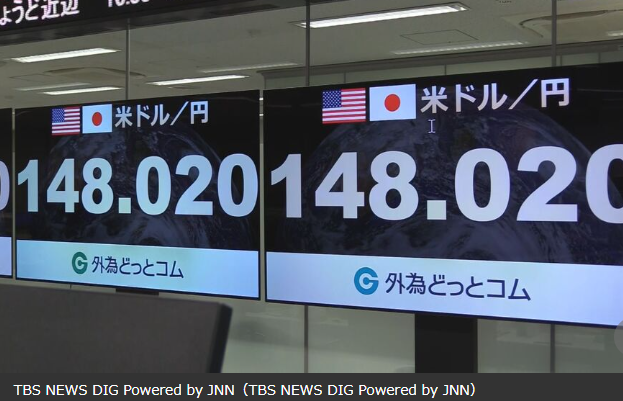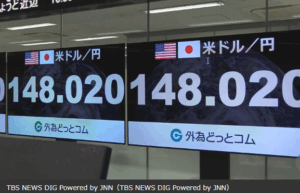【Shigeo’s Review】
In the Tokyo foreign exchange market on January 12, the yen temporarily hit the upper 148 yen per dollar level, the weakest level in about a month since last month’s 10th.
The U.S. and China announced earlier that they will reduce tariffs imposed on each other by 115%. The yen weakened by nearly 2 yen at one stroke as the view that friction between the U.S. and China would be reduced more than expected spread, and people began to sell yen to buy dollars.
On the 12th, the yen temporarily hit the upper 147 yen per dollar level on the Tokyo Foreign Exchange Market, the weakest level in about a month since the 10th of last month.
This sharp depreciation of the yen was largely due to the announcement of a 115% reduction in tariffs that had been mutually imposed by the U.S. and China. The tariff reduction has given the market expectations that economic friction between the two countries will be eased more than expected, and as a result, the yen has been selling off and the dollar has been buying.
First of all, the indication of an improvement in the U.S.-China relationship is very important news for the global economy.
The long-running trade friction between the U.S. and China has created a great deal of uncertainty in the global supply chain and investment environment.
For Japanese exporters in particular, the reduction in tariffs was a boost to expectations of a recovery in economic activity, as the Chinese and U.S. markets have a significant impact on their business. This news prompted investors to take a risk-on stance, selling the yen as a safe-haven asset and accelerating their buying of the dollar, which has high growth expectations.
Secondly, it should be noted that the yen rapidly weakened by nearly 2 yen. Currency markets are extremely sensitive, and such policy announcements and diplomatic agreements can cause large fluctuations in the market in a short period of time.
This move indicates not only temporary news, but also that the market has come to accept the prospect of an improved economic environment in the future.
For the Japanese economy, a weaker yen improves export competitiveness, but it also poses challenges such as higher import prices and higher living costs.
Therefore, it is necessary to carefully assess the advantages and disadvantages of the yen’s depreciation.
The yen’s depreciation will also affect monetary policy and the outlook for economic growth.
The Bank of Japan has long maintained an ultra-low interest rate policy, and a weakening yen may stimulate debate on the revision of monetary policy by improving the earnings of exporting firms and increasing inflationary pressure.
On the other hand, stabilization of the global economy through improved U.S.-China relations is also expected to contribute to higher growth in Japan, and it can be said that the market reflected this by buying the dollar and selling the yen more strongly.
Overall, the announcement of the U.S.-China tariff reduction had a positive impact on the global economy and currency markets.
The yen’s depreciation to the upper half of the 147-yen per dollar range can be understood as a result of market participants’ incorporation of future improvements in the economic environment.
However, whether this trend will be sustained depends on the future progress of the U.S.-China negotiations and economic indicators in Japan and abroad, and uncertainties still exist.
Investors and policy makers need to closely monitor the impact of such exchange rate fluctuations on the Japanese economy as a whole and consider appropriate responses.
The developments in the foreign exchange market on December 12 were thus a typical example of how changes in the international political economy can have an immediate and significant impact on foreign exchange rates.
Going forward, Japan must continue to closely monitor the U.S.-China relationship and the global economic situation, and flexibly adapt its foreign exchange policy and economic strategy.


